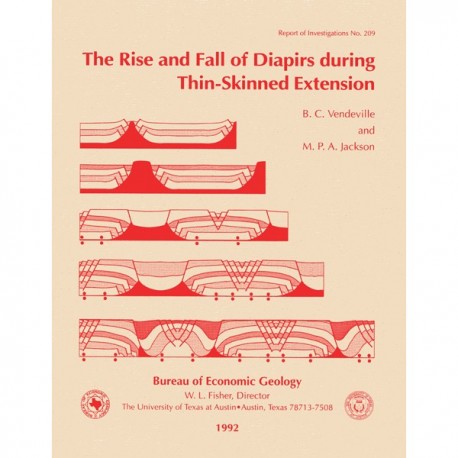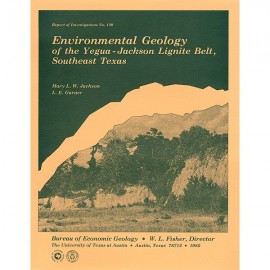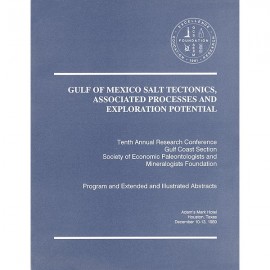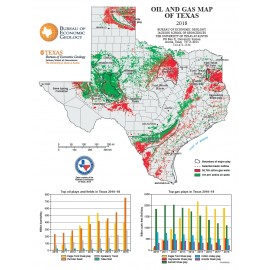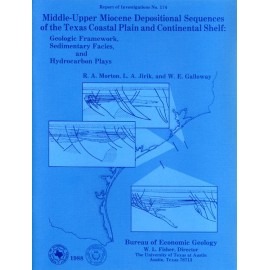Reports of Investigations
-
Books & Reports
- Reports of Investigations
- Guidebooks
- Udden Series
- Geological Circulars
- Down To Earth
- Atlases of Major Oil and Gas Reservoirs
- Texas Memorial Museum Publications
- Environmental Geologic Atlas of the Texas Coastal Zone
- Mineral Resource Circulars
- Other Reports
- Seminars and Workshops
- Handbooks
- Submerged Lands of Texas
- Symposia
- Annual Reports
- Open File Reports
-
Maps & Cross Sections
- Thematic Maps
- Miscellaneous Maps, Charts & Sections
- Geologic Atlas of Texas
- STATEMAP Project Maps
- Geologic Quadrangle Maps
- Cross Sections
- Highway Geology Map
- Energy and Mineral Resource Maps
- Shoreline Change and Other Posters
- Wilcox Group, East Texas, Geological / Hydrological Folios
- Bouguer Gravity Atlas of Texas
- River Basin Regional Studies
- Featured Maps
- Posters
- Teachers & the Public
-
Geological Society Publications
- Gulf Coast Association of Geological Societies
- Alabama Geological Society
- Austin Geological Society
- Corpus Christi Geological Society
- Houston Geological Society
- Lafayette Geological Society
- Mississippi Geological Society
- New Orleans Geological Society
- South Texas Geological Society
- GCS SEPM Publications
- Historic BEG & UT Series
RI0209. The Rise and Fall of Diapirs During Thin-Skinned Extension, by B. C. Vendeville and M.P.A. Jackson. 60 p., 51 figs., 1992. Print.
To purchase this publication as a downloadable PDF, please order RI0209D.
ABSTRACT
Grabens overlying diapirs have previously been ascribed to intrusion, withdrawal, or dissolution of salt. We propose, however, that many grabens or half grabens above diapirs form by regional thin-skinned extension of a brittle overburden. This regional extension can initiate and promote piercement of diapiric walls through extremely thick overburdens. This Piercement induced by faulting applies regardless of the overburden density. These conclusions cast doubt on some axioms of salt tectonics and are supported by dynamically scaled physical modeling, theoretical reasoning, and observations from seismic sections.
A diapir pierces a thick, brittle overburden in three evolutionary stages: reactive, active, and passive. Diapirs initially grow by reactive piercement, a newly proposed mechanism in which the diapir rises in response to faulting during regional extension. The hanging wall of an initial fault sinks into the source layer until resisted by increasing pressure forces in the source layer and bending resistance in the overburden. New faults form repeatedly nearer the axis of the graben. The dwindling central fault block sinks while the diapir rises below it, regardless of overburden density. Progressively smaller fault blocks are supported by the fluid pressure at progressively higher levels flanking a triangular diapir. Sedimentation keeps diapirs in the reactive stage longer by filling the graben. Reactive diapirism is controlled by the rate of regional extension: whenever regional extension ceases, reactive diapirs stop growing. If the diapir becomes tall enough, its roof sufficiently thinned, and the fault trough deep enough, a diapir can pierce actively by lifting and shouldering aside its roof to emerge rapidly at the surface. During subsequent passive piercement, a diapir widens by regional extension and increases in relief by downbuilding during concurrent sedimentation. Diapirs can also be initiated directly into the passive (thereby bypassing the reactive and active) mode of growth by differential loading if the overburden is thin. Faulting, folding, and thickness changes are negligible around passive diapirs. Rounded stocks can evolve passively from walls initiated by grabens.
The same regional extension that initiates and promotes the rise of diapirs can eventually make diapirs fall. During regional extension, diapirs widen between separating blocks of overburden but begin to subside when salt supply eventually becomes restricted. The formerly rising diapiric crest rapidly transforms into a site of vigorous subsidence and deposition. This site is typically a linear or even circular graben that indents the diapir crest, leaving residual horns of salt, which could be misinterpreted as injections into faults. Potential incompatibilities between deformation in the diapir and in its roof are resolved by local modification of fault geometry or by flow of salt along the diapiric wall from depressions into intervening culminations. Turtle-structure anticlines with keystone grabens form between subsiding walls. During extreme extension, diapirs subside until they are segmented into relics by indenting crestal grabens. Such grabens can eventually ground onto basement and invert to form mock turtle anticlines. Second-cycle diapirs rise from extrusive allochthonous sheets during fall of the parent diapir. Most structures produced by diapir fall during regional extension are conventionally attributed to salt dissolution or forceful intrusion; all three possibilities should be evaluated by the criteria discussed here.
Keywords: diapirism, extension, faulting, grabens, physical modeling, salt domes, salt tectonics
CONTENTS
Abstract
Introduction
Part 1: Diapir Rise
Background
Salt Upwelling and Extension Associated in Time
Why Extension Should Favor Diapirism
Rheologic behavior
Mechanical considerations
Diapirism during Extension after Sedimentation
Kinematics of reactive diapirism
Dynamics of reactive diapirism
Active diapirism
Passive diapirism
Summary of the three stages of diapirism
Diapirism during Extension and Sedimentation
Reactive diapirism
Active diapirism
Passive diapirism
Summary
Diapir Shape Controlled by Rates of Extension and Deposition
Flexure during Diapirism
Part 2: Diapir Fall
Introduction
Inconsistencies and Contradictions in Previous Interpretations
Arching-Related Faulting above Diapirs
Criteria Eliminating the Possibility of Dissolution and Arching
Inapplicability of dissolution to shale diapirs
Inapplicability of dissolution without cap rock
Inapplicability of dissolution to deep salt diapirs encased in shale
Inapplicability of dissolution with rapid sedimentation
Inapplicability of dissolution without extension
Inapplicability of dissolution in palinspastic restorations
Inapplicability of arching without force folding
Inapplicability of arching because of age relations
Inapplicability of arching in thick overburdens
Inapplicability of gentle arching as a cause of major grabens
Experimental Evidence
Why Diapirs Sag While They Widen
Examples from Nature
Examples with moderate extension
Examples with extreme extension
Part 3: Conclusions
Acknowledgments
References
Figures
1. Block diagram illustrating a prevailing double standard for interpreting fault and salt tectonics
2. Map of the northern Red Sea showing linear diapiric walls parallel to and closely associated with grabens and half grabens
3. Pressure distribution in a pressurized fluid overlain by a rigid, brittle overburden
4. Schematic conditions for piercement of nonextensional structures above salt ridges or below topographic troughs
5. Vertical sections through models of reactive diapirism during thin-skinned extension
6. Overhead view and vertical section of a stairstep graben overlying a reactive diapir
7. Overhead view of a stairstep graben overlying a reactive diapir and vertical section through a model of
reactive diapirism during thin-skinned extension
8. A tracing of figure 5C and its restoration showing fault blocks in their preslip positions
9. Kinematics of symmetric reactive diapirism during regional extension
10. Vertical section through an asymmetric reactive diapir overlain by a half graben
11. Kinematics of asymmetric reactive diapirism during regional extension of a prekinematic sequence
12. Vertical cross section of Heidelberg Dome, Mississippi, showing large normal faults associated with the crest of the triangular diapir of Louann Salt
13. Pressures in a fluid layer and displacements and flexural strains in an overburden during reactive diapirism, assuming that the first two faults form sequentially
14. Pressures in a fluid layer and displacements in an overburden during reactive diapirism, assuming that the first two faults formed together as a conjugate pair
15. Effect of extension rate and source-layer viscosity on structural style of a stairstep graben above a pressurized fluid
16. Model section after 6.5 cm extension (6.5 h duration) showing a reactive diapir that has evolved to the active stage of piercement
17. Automatic tracing of a seismic profile of an actively piercing diapir of Argo Salt in the extensional Whale basin off Newfoundland
18. Summary of the three stages of diapiric piercement through prekinematic overburden during thin-skinned extension
19. Effects of aggradation on preventing reactive diapirism
20. Photograph and tracing of a vertical section through a model of a syndepositional reactive diapir produced by regional extension
21. Vertical section through a symmetric reactive diapir that has pierced a prekinematic layer and seven synkinematic layers, each added every 12 h
22. Vertical section through an asymmetric reactive diapir that has pierced an entirely synkinematic overburden containing nine layers, each added every 2 h
23. Cross section through a syndepositional reactive diapir, the South Timbalier Block 54 dome of Louann Salt, offshore Louisiana
24. Serial sections through an elongated diapiric model produced by regional extension
25. Vertical section of Lake Barre dome of Louann Salt, Louisiana Gulf Coast
26. Summary of the three stages of diapiric piercement through synkinematic overburden during thin-skinned extension
27. Restored sections of experimental diapirs that grew during extension and slow aggradation
28. Restored sections of experimental diapirs that grew during extension and deposition
29. Automatic tracing of a seismic profile of Xenophon diapirs of Messinian salt, southeast Mediterranean, and seismic profile of the Sigsbee diapirs of Challenger Salt, abyssal Gulf of Mexico
30. A potential effect of flexural rigidity
31. Vertically exaggerated seismic profile across the Levant platform, southeastern Mediterranean Sea
32. Vertical section through the reactive diapir illustrated in figure 20
33. Tracings from seismic profiles of North Sea elongated salt domes overlain by arched and normally faulted overburden
34. Tracings of seismic time sections from opposite sides of the South Atlantic Ocean, illustrating very different explanations for what are almost twin structures
35. Overhead views of an experimental model of thin-skinned extension above salt
36. Tracing of a vertical section through several structures in the final stage of experiment 25
37. Schematic reversal of rotation direction of rafted fault blocks as they tilt and ground onto basement below the source layer
38. Vertical sections of the final stage of experiment 25, showing progressive fall of a diapir documented by structural variations along strike after the same duration of deformation
39. Vertical sections in the final stage of experiment 25
40. Vertical sections through models with entirely synkinematic overburdens, showing subsiding diapirs with indenting grabens
41. Schematic rise and fall of diapirs during sedimentation
42. Keystone grabens formed by local stretching of the crests of turtle-structure anticlines
43. The rise of second-cycle diapirs from a buried extrusive sheet at the rim of a syncline over a diaper compelled to subside during regional extension and episodic sedimentation
44. Diagram showing changes in diapir area and in the gap between fault blocks
45. Schematic vertical sections showing the rise and fall of a diapir through prekinematic overburden during regional thin-skinned extension
46. Diagrams showing the effect of initial diapir shape on the mass balance of salt during regional extension
47. Three-dimensional linkage between extension of a graben overlying a subsiding depression and adjacent rising culminations of the wall
48. Tracing of a seismic profile from the northwestern Mediterranean Sea
49. Serial sections traced from seismic profiles across a salt wall
50. Restoration of a falling diapir in the Kwanza basin of Angola
51. Schematic summary of the characteristic features of reactive rising diapirs compared with those of falling diapirs
Citation
Vendeville, B. C., and Jackson, M. P. A., 1992, The Rise and Fall of Diapirs During Thin-Skinned Extension: The University of Texas at Austin, Bureau of Economic Geology, Report of Investigations No. 209, 60 p.
